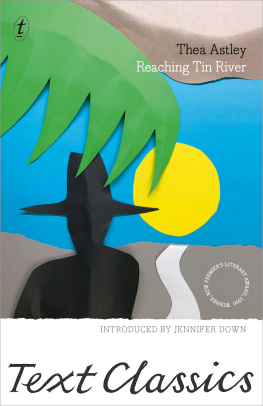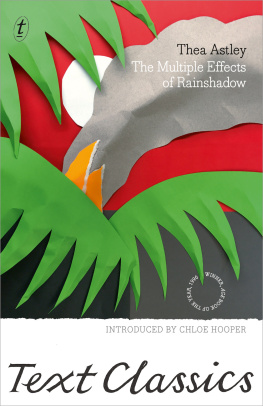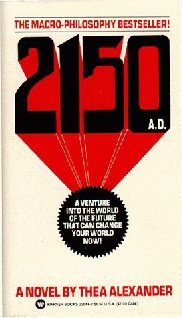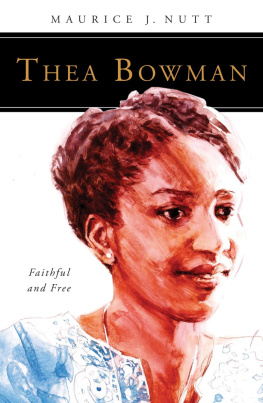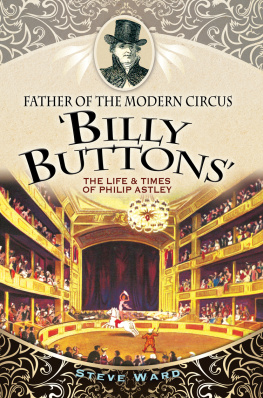
Tin River is a townlet of terminal attractiveness.
Tin River is a state of mind.
Researching in the archives Belle discovers the long-dead Gaden Lockyer, a colonial pioneer in Jericho Flats, and soon becomes obsessed. Belles quest for Lockyer is her way of coming to terms with the pastwith her mother, a drummer in her own all-womens group; her absent American father; and her ineffectual husband, Seb.
In Reaching Tin River, Thea Astleys satire is at its sharpest and most entertaining.
Intelligent, fresh, and new. Kirkus Reviews
Text Classics
was born in Brisbane in 1925. She attended All Hallows, a Catholic school in Fortitude Valley, before studying arts at the University of Queensland.
Astley trained to be a teacher and, on marrying Jack Gregson in 1948, moved to Sydney and worked in a number of schools. The pair had a son, Ed.
In 1958 Astleys first novel, Girl with a Monkey, was published. Over the next four decades she published a work of fiction every few years. Her novels and short stories are distinguished by vivid imagery and metaphor; a complex, ironic style; and a desire to highlight oppression and social injustice.
Astley won the Miles Franklin Literary Award for The Well Dressed Explorer (1962), her third novel. Many notable books followed, among them the groundbreaking A Kindness Cup (1974), which addressed frontier massacres of Indigenous Australians, and Its Raining in Mango (1987).
In the late 1960s Astley took up a position at Macquarie University, where she worked until 1980, when she began to write full-time. She and her husband moved to North Queensland, returning to New South Wales later that decade.
Astley won the 1989 Patrick White Award and became an Officer of the Order of Australia in 1992. Her last novel was Drylands (1999), her fourth Miles Franklin winner and first since 1972.
Famed for her lifelong sharp wit, Thea Astley died in 2004, the year after her husband died. She is considered to be one of the most distinctive and influential Australian novelists of the twentieth century.
debut novel, Our Magic Hour, was highly commended in the Victorian Premiers Literary Awards and shortlisted in the New South Wales Premiers Literary Awards. She was a Sydney Morning Herald Young Novelist of the Year in 2017. Her short-story collection, Pulse Points, was published the same year.
Girl with a Monkey
A Descant for Gossips
The Well Dressed Explorer
The Slow Natives
A Boat Load of Home Folk
The Acolyte
A Kindness Cup
Hunting the Wild Pineapple and Other Related Stories
An Item from the Late News
Beachmasters
Its Raining in Mango
Vanishing Points
Coda
The Multiple Effects of Rainshadow
Drylands
Collected Stories
textclassics.com.au
textpublishing.com.au
The Text Publishing Company
Swann House
22 William Street
Melbourne Victoria 3000
Australia
Copyright estate of Thea Astley, 1990
Introduction copyright Jennifer Down, 2018
The moral rights of the authors have been asserted.
All rights reserved. Without limiting the rights under copyright above, no part of this publication shall be reproduced, stored in or introduced into a retrieval system, or transmitted in any form or by any means (electronic, mechanical, photocopying, recording or otherwise), without the prior permission of both the copyright owner and the publisher of this book.
Every effort has been made to trace copyright holders and obtain their permission for the use of copyright material. The publisher apologises for any errors or omissions and would be grateful if notified of any corrections that should be incorporated in future reprints or editions of this book.
First published by William Heinemann Australia, 1990
This edition published by The Text Publishing Company, 2018
Cover design by W. H. Chong
Page design by Text
Typeset by Midland
ISBN: 9781925603552 (paperback)
ISBN: 9781925626599 (ebook)
CONTENTS
AND ANOTHER START.
For all the richness of its world, the warmth of its characters and the joyfulness of its writing, Reaching Tin RiverThea Astleys eleventh novel, first published in 1990opens tentatively. In fact, the narrator, thirty-something Belle, begins six times.
Either her story begins with a snappy precis of her pursuit of a long-dead colonial pioneer; or with a one-line snapshot of her mother, a drummer in her own all-womens group, a throbber of a lady with midlife zest and an off-centre smile; or with a touch of facetiousness as she describes subverting boredom by tallying all the convent girls who plinked away at The Rustle of Spring on the piano.
Or with the misery of being wrenched, aged seven, from the family sheep property on Perjury Plains to boarding school. Or with the moment during an unhappy trip to New Caledonia when she discovers her husband trying to hump the house girl. (Importantly, she adds, I say trying.)
Or perhaps it begins where it endswith Tin River, the eponymous fictive coastal town which, like a horizon line obscured by fog and foreshore and stucco motels, seems impossibly distant until the precise moment at which it is abruptly revealed. Indeed, Tin River is a state of mind.
This hesitant beginning, however, is no uncertainty on Astleys part. It is a careful introduction to our heroine, Belle: inward-focused, often questionably reliable, occasionally scattered, but always a delight to witness. And thats what it is, to read this novel. A little witnessing. We are less a part of the narrative than we are captive bystanders to it. And Astleyas youd expect from a writer who in the course of her career published fifteen novels and received four Miles Franklin Literary Awardsmakes it work.
Until recently, I had not read Reaching Tin River, though I had admired several other novels by Thea Astley. If I had investigated its premise beforehanda woman becomes obsessed with a long-dead man she glimpses in an archival photograph of early settlersI am not certain I would have chosen to read it. Frankly, Ive had my fill of novels about dead white men, of novels that romanticise our colonial past. And yet I should have known that I would be safe in Astleys hands. Gaden Lockyer, the subject of Belles fixation, takes on a metonymic quality. He could, arguably, be anyone. Belle longs to tear a hole in her world, and even attempts to do so literally, in a fantastically weird moment in which she leaps through a life-sized poster of Lockyer and his family, making sure it is Mrs Lockyer I obliterate.
Early in the novel, Belle recalls herself aged nine, struck by a sudden melancholy in the middle of a lonely game of shopgirl under her grandparents veranda. I want love, I heard myself whispering. Im not sure what I meant. The reader, on the other hand, is only too aware of her meaning. As far as love goes, Belle is chronically undernourished, a woman unsatisfied. She is achingly adrift, in search of her centre.
Her mother, Bonnie, is rarely particularly maternal and her presence is spasmodic. Her American father is a mere spectre for much of the novel. Belle meets him only once, as an adult, in a Manhattan jazz bar. Growing up, she rebuffs sex and intimacy until, in a scene both comic and grim, over dinner one night she is propositioned by Seb, her bombastic librarian co-worker:
My deargiven the fact that I am thirty-seven and assuming I have forty years ahead of me, would you be prepared on a permanent basis to cook me fourteen thousand six hundred dinners, the same number of breakfasts, give or take a few? Ill see to my own lunch, the generous fellow added. And do approximately two thousand loads of washing and ironing, house cleans and shopping?
Next page
